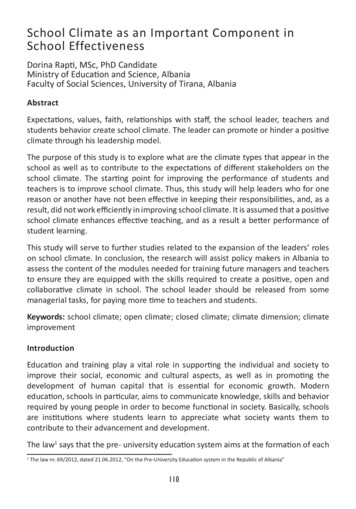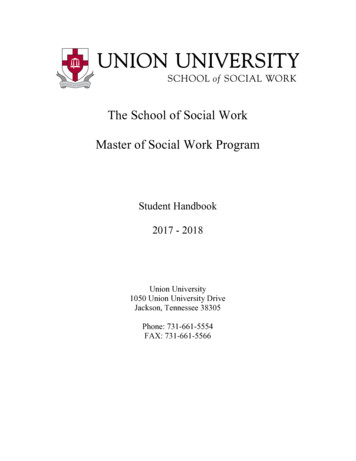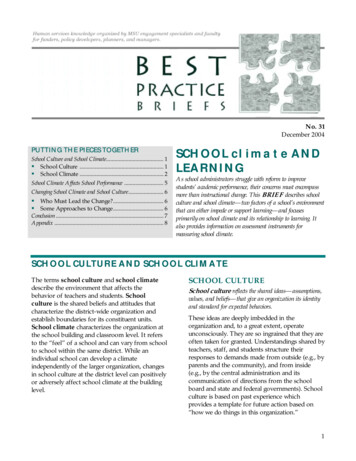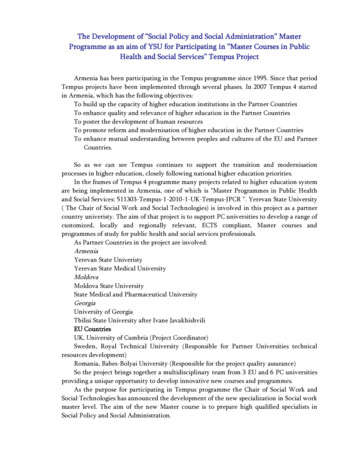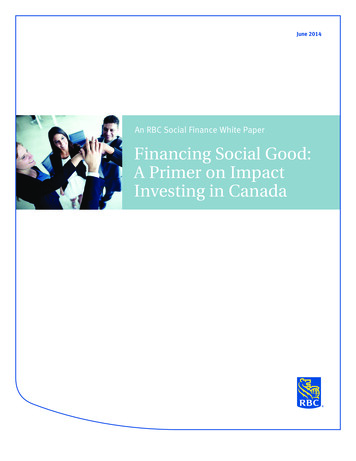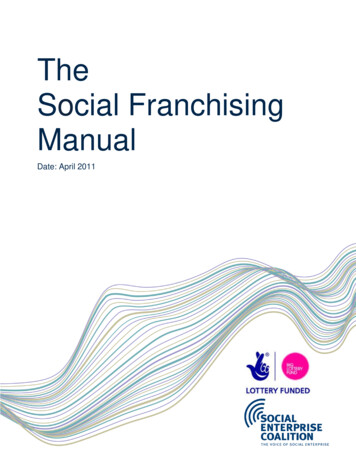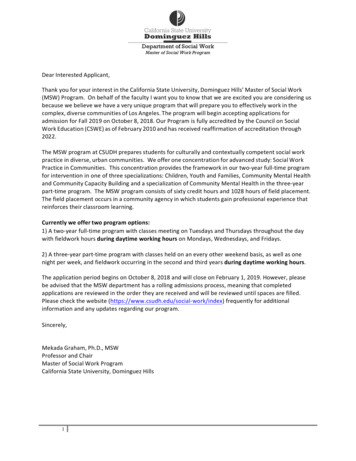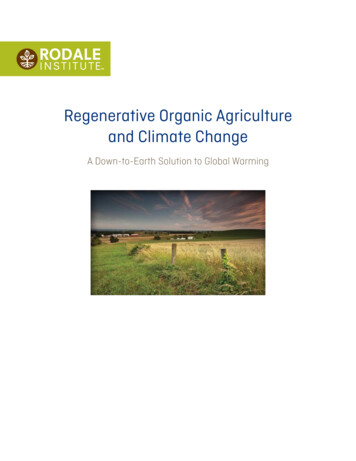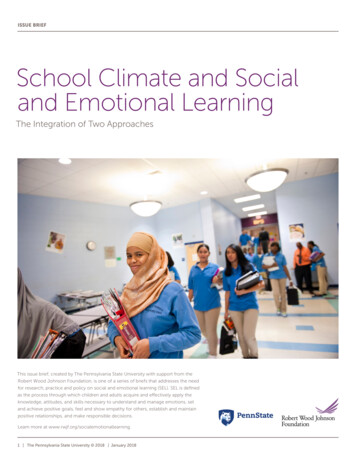
Transcription
issue briefSchool Climate and Socialand Emotional LearningThe Integration of Two ApproachesThis issue brief, created by The Pennsylvania State University with support from theRobert Wood Johnson Foundation, is one of a series of briefs that addresses the needfor research, practice and policy on social and emotional learning (SEL). SEL is definedas the process through which children and adults acquire and effectively apply theknowledge, attitudes, and skills necessary to understand and manage emotions, setand achieve positive goals, feel and show empathy for others, establish and maintainpositive relationships, and make responsible decisions.Learn more at www.rwjf.org/socialemotionallearning.1 The Pennsylvania State University 2018 January 2018
issue briefExecutive SummaryHealthy schools support student learning, development, and well-being by providing safety,support, academic challenge, healthy foods, time and space to be active, and opportunitiesfor social and emotional development. In healthy schools, both students and educators feelrespected and supported. Healthy schools require a positive school climate that supportsthe social and emotional development of students and adults. Such a climate can reduceinequities and enable students to thrive.School climate has been conceptualized to include the physical, academic, social, anddisciplinary environment. School climate and social and emotional learning (SEL) have oftenbeen treated separately by researchers and practitioners, but both are necessary to buildhealthy schools, are co-influential, and benefit each other. A positive school climate createsthe conditions for SEL; the social and emotional competence of each member of the schoolcommunity, both individually and collectively, affects school climate.This brief reviews research on how positive school climates support SEL and how improvedSEL contributes to improved school climate in elementary and secondary schools. The briefdiscusses school climate, SEL, and blended models that have effects on school climate andsocial and emotional competence.Efforts to improve school climate and SEL can be aligned. Schools can actively fosterresilience-building interactions through inclusive school-level policies and initiatives, aswell as comprehensive, multi-tiered, whole-school approaches that contribute to positiveclimates and actively develop social and emotional competencies in students and adults.However, there is still a need for rigorous research that carefully assesses individual andschool development in, and provides practical understanding of the application of bestpractices for, building positive school climates that create opportunities for SEL.2 The Pennsylvania State University 2018 January 2018
issue briefIntroductionHealthy schools are characterized by positive school climates that support student learning,development, and well-being by providing safety, support and connectedness, academicchallenge and engagement, cultural responsiveness, healthy foods, time and space to beactive, and SEL.School climate and social, emotional, and academic competencies have publichealth benefits.1,2 They both are multifaceted and complex constructs, and have beenconceptualized and measured in many ways:School climate has been conceptualized to include the physical, academic, social, anddisciplinary environment. This definition includes culture, norms, goals, values, practices,characteristics of relationships, and organizational structures.3,4 In this brief, we focuson components of school climate that are most directly related to learning, behavior,development, and well-being, including: student and adult experiences of emotional,physical, social, and intellectual safety, connectedness, respect, support, engagement,relational trust, and cultural responsiveness. These concepts have been conceptualizedas conditions for learning.5SEL refers to the process of learning, practicing, and building competencies such asself-awareness, self-management, social awareness, relationship skills, and responsibledecision making. SEL interventions in schools have been shown to both improve schoolclimate and student’s behavioral and academic functioning.6,7,8,9School climate and SEL have been studied separately. The school climate tradition wasinformed by organizational and school effectiveness research.10 School climate includesthe interactions of all members of the school community; larger organizational patternsincluding culture, structure, and resources; and how individuals experience and appraisethese interactions and patterns.The emergence of SEL as a field was influenced, in part, by ecological and transactionalmodels of development, which carefully consider the bidirectional relations betweenchildren and contexts in which they are embedded that foster students’ social, emotional,and academic competence.11,12 The goals of SEL programs are to simultaneously nurturechildren’s skills and classroom and school practices that provide opportunities fordevelopment in everyday situations.13 Most SEL programs have, until recently, been confinedto teaching skills through designated lessons in the classroom and have not been fullyintegrated into the daily lives of students and adults in school.14 The research evidence islargely based on evaluations of these programs, and the lack of integration into regularroutines of classrooms and schools is one reason for modest effect sizes of SEL programs.3 The Pennsylvania State University 2018 January 2018
issue briefThis disconnect between an historical focus on SEL programs and the need to developbroader school climates that support SEL can be attributed to factors including lack offunding, lack of teacher preparation, and lack of school and district infrastructure to supportcoordinated efforts.15In the past decade, a new wave of programs has acknowledged this limitation. There is now asignificant move towards coordinated, systematic, schoolwide and districtwide programmingthat is ecological, integrates school climate and SEL approaches, and prioritizes theengagement of the larger school community.16 This new wave includes systematic efforts tointegrate and build positive school climates that support SEL, such as the ASCD’s Whole ChildInitiative,17 the National Commission on Social, Emotional, and Academic Development,18 andrecent efforts to create a Science of Learning and Development.19School climate and SEL have considerably more overlap and are more mutually influentialthan their traditions would suggest. Positive school climates and effective SEL approachesare essential components of safe, supportive, and academically productive schools.20 Schoolclimate is the collective phenomenon that both reflects and creates the conditions for thedevelopment of social, emotional, and academic competence in both adults and students.Aligning school climate and SEL can create synergies, reduce fragmentation and burden ofpractice change, and advance research.It’s also important to acknowledge that there are disparities in how students experienceschool climate. Students of color and students who are economically disadvantaged aremore likely than their peers to report poorer school climates, including experiencing harshand exclusionary discipline. By developing practical understanding and applications of howto create inclusive, culturally competent school climates for all students and staff, schoolscan reduce inequities and contribute to healthy development and well-being.This research brief reviews how positive school climates support SEL and how improvingsocial, emotional, and academic competence contributes to improved school climate.Specifically, the brief describes the components of positive school climates that support SELin elementary and secondary schools.4 The Pennsylvania State University 2018 January 2018Aligning schoolclimate andSEL can createsynergies, reducefragmentation andburden of practicechange, and advanceresearch.
issue briefKey FindingsSupportive relationships, engagement, safety, cultural competenceand responsiveness, and academic challenge and high expectationscreate positive school climates that can help build social andemotional competence.Figure 1 illustrates the relationship between climate and social and emotional competence.The circle on the left shows the components of school climate that indirectly shape SEL. Thecircle on the right identifies competencies that shape and are shaped by school climate. Theoverlapping area in the center identifies the elements of positive school climates that directlysupport SEL. Here we focus on the central area—those elements of positive school climatesthat create conditions that support intentional as well as informal SEL.At the heart of what it takes for students to thrive are supportive, respectful, trustingrelationships. Overlapping components (see Figure 1) support these relationships:Engagement. When students experience engagement and feel a sense of belonging andconnection with adults and peers at school, they can build social capital and more readily useadults as social models, accept feedback, and navigate and persevere through challenges.21Safety. When students and staff feel safe, they are more willing to focus on learning fromand with others and take academic risks.Figure 1. A model of the distinct and overlapping elements of school climate and social andemotional competence with illustrative componentsSchool climatellllllllPolicies, procedures,and normsCultural contextPhysical environmentPartnershipswith families andcommunity5 The Pennsylvania State University 2018 January 2018Social and emotionalcompetencellllllllllllSupportive relationshipsEngagementSafetyCultural competenceCultural responsivenessChallenge and highexpectationsllllllllSocial andemotional skillsValuesPerspectivesIdentities
issue briefCultural competence. Cultural competence is a set of behaviors, attitudes, and policiesthat enables schools, agencies, and teachers to work more effectively in bicultural andmulticultural settings and interactions.22 Cultural competence can help adults be aware ofprivilege, implicit bias and micro-aggressions. Culturally competent schools help educatorsengage students and families by creating conditions where students and families feel a senseof belonging, support, respect, and safety.23Cultural responsiveness. Culturally competent teachers can use their knowledge ofstudents to be more instructionally responsive. Culturally responsive instructional approachesare engaging, participatory, and use diverse instructional models to scaffold learning byusing students’ own cultural knowledge to teach new concepts, connect experiences insideand outside the classroom, and master new information.24 Such approaches can addressthe social and emotional and learning needs of culturally and linguistically diverse studentsby creating learning environments where students feel emotionally and intellectually safe,supported, and challenged.25Culturally competent school climates and culturally responsive approaches and practices canhelp students build strengths-based individual and collective narratives and can help studentscounteract negative dominant narratives, such as prejudicial stereotypes.Challenge and high expectations. Students are more personally motivated to succeed,more actively engaged in learning, and work better with others when they, their peers, andadults have high expectations for achievement that are experienced as relevant to them;when they are surrounded by peers who have academic aspirations; and when curricula,pedagogy, and opportunities to learn are rigorous, engaging and aligned with their goals.26Leaders are essential to creating the conditions to build teachers’ social and emotionalcompetencies. Teachers are more likely to develop these skills when leadership bothprioritizes and models these competencies. Teachers who have social and emotionalcompetence (SEC) can model it to support student behavior and learning.27The relationship between positive school climate and SELis interactive and co-influential, it occurs in all settings andstudent-teacher-staff interactions, and influences studentsand teachers directly and indirectly.There is a dynamic relationship among aspects of school climate and SEL. Student and adultsocial and emotional competencies influence and are influenced by interactions amongstudents and adults. These interactions can intentionally develop SECs through directinstruction, modeling, and reinforcement. These interactions occur across the various settingsof the school building. In addition, factors such as class size, how students are grouped,student-faculty ratios, policies, resource allocation, the physical features of the school,rituals, narratives, school culture, and the demographic composition of the school also affectinteractions. In turn, these features influence and are influenced by out-of-school contexts thatinclude availability of community centers and other community supports, community risk andprotective factors, family needs and concerns, how students get to school, and social networks.6 The Pennsylvania State University 2018 January 2018
issue briefSchool Climate Social EmotionalLearningThe relation between school climate and SEL is bidirectional. School climate affects SEL andvice versa in a dynamic manner. For example, when there is less bullying and violence in theclassroom and school, students become less fearful, employ non-violent methods of conflictresolution, and interact more effectively, cooperatively, inclusively, and productively. As a result,there are fewer disciplinary incidents and disruptions of learning, allowing for better resourceallocation leading to positive learning outcomes.28 At the same time, the acquisition of SECcontributes to a safer school environment.29The relation between school climate and SEL occurs across levels of the school system.The mutually reinforcing relationship between school climate and SEL occurs in momentto-moment interactions within classroom and school settings. It also is embedded withinother climate-related factors (e.g., organizational systems, policies, procedures, the physicalenvironment, and cultures and norms), with are in turn embedded within communitysettings. These repeated interactions set patterns and norms in one-on-one and larger groupinteractions. School climate and SEL also shape and are shaped by the policies and proceduresthat determine responses to misbehavior, resource allocation, the level of collaborationamong staff and between schools and the community, and access to prevention andintervention services in schools.7 The Pennsylvania State University 2018 January 2018
issue briefThe relation between school climate and SEL is multidimensional. School climate and SELeach have multiple components. School climate includes elements of safety, engagement,relationships, teaching and learning, and environment, and can be measured at the schooland classroom levels. SEL involves the development of individual skills, knowledge, anddispositions. One component of school climate can mutually influence other componentsof school climate as well as one or more SEL components. For example, teacher supportcontributes to how students regulate their behaviors in the classrooms, just as students’ selfregulation skills contribute to teachers’ capacities to create supportive classroom conditions.Most often, multiple components of school climate and SEL are present at the sametime. For example, culturally responsive relationships both create and are aided by howemotionally and physically safe students and adults feel. These two components of schoolclimate, in interaction, can create and aid the development of multiple social and emotionalcompetencies in students and adults, such as social awareness and confidence.The interaction of school climate and SEL creates ripple effects in the school. A specificinteraction between a student and a teacher may affect not only those directly involvedbut also surrounding students and adults. For example, disruptive student behavior maydistract teachers or cause teacher stress, both of which can have effects on how the teacherappraises the behavior of and responds to other students. Similarly, a positive or negativeprincipal-staff interaction may have ripple effects across the staff that may impact studentswhen they witness and potentially model adult behaviors.Rigorous evaluations of school climate and SEL approaches haveprovided some direct evidence that one can improve the other.School climate approaches. Schools have the potential to serve as powerful protectivefactors in students’ development.30 Schools are relatively self-contained environments andcan be safe spaces for children and their families.31 Schools can counteract alienation andisolation students may feel by actively fostering resilience-building interactions.32 Schoolsthat foster a sense of belonging can help reduce depression, increase self-efficacy, andprovide opportunities to build self-confidence and relationship-building skills.33,34 Schoollevel policies and initiatives such as anti-harassment policies, providing safe spaces for youthwho are marginalized, and enlisting the resources of families and other community membersfrom marginalized groups can reduce negative outcomes in young people.35,36The most effective approaches to improving school climate can create conditions for SEL andengage multiple members of the school community. These efforts have not been entirelyseparate from SEL approaches and are sometimes used as an organizing approach forprevention efforts, including character and moral education, civic education, and risk/mentalhealth promotion efforts.37 Although there is great interest in improving school climate, limiteddirect evidence exists for the effectiveness of school climate or whole-school approaches8 The Pennsylvania State University 2018 January 2018Schools have thepotential to serve aspowerful protectivefactors in students’development.
issue briefin promoting social and emotional development. One noteworthy exceptionis the Caring School Community program, which, by aiming to create a senseof community while also developing social and emotional skills, combineselements of both school climate approaches and SEL programs.38 In addition,there is some evidence that schools with more positive school climate havehigher implementation of SEL programs. The universal components of SchoolWide Positive Behavioral Interventions and Supports (SWPBIS), a preventionframework for both improving school climate and providing additional tiers ofbehavior supports to appropriate students, has also shown positive impacts onstudents’ emotion regulation, prosocial behavior, and concentration, in additionto improving perceptions of safety, academic performance and reducingbullying and office disciplinary referrals.39,40The Center on GreatTeachers and Leadersidentifies 10 teachingpractices that promotestudents’ social andemotional competencies1. Student-Centered Discipline2. Teacher LanguageSome approaches show promise but have not yet been rigorously evaluated.Disciplinary approaches such as authoritative discipline and restorativepractices show promise for reducing re-traumatization and contribute toemotional and physical safety and equity.41,42 Universal trauma-sensitiveinterventions can include creating a warm and caring school, teachertraining on the impacts of trauma, alternatives to suspension, and classroompresentations on coping with trauma and violence. Trauma-informedinterventions can include trauma-informed approaches to SEL that addressindividual needs, trauma-informed approaches to discipline, and traumainformed psychotherapies.43SEL approaches. SEL programs and practices vary in their approaches.44,45 Someprograms focus solely on teaching skills exclusively in a lesson format, whileothers also nurture students and teachers to use these skills across the schoolday and school settings. Programs also provide professional development todifferent people; some focus only on classroom teachers, while others extend toall adults who work in the schools (from the principal to playground, lunchroomand transportation staff). Based on a review of evidence-based SEL programs,The Center on Great Teachers and Leaders identified 10 instructional strategiesfor improving SEC.46Some SEL programs take more comprehensive approaches by providingprocedures for community-family-school involvement and partnership. Thesemore comprehensive programs aim to develop the environmental conditionsfor skill acquisition, reinforcement, and recognition.47,48 For example, some SELinterventions strive to provide high expectations for students, support fromadults, structured and cooperative learning environments, and safe and orderlyschools to produce improvements in children’s engagement, prosocial behavior(and reduction in antisocial behavior) and academic success.49 Evaluations ofthese programs have shown positive short-term effects, but implementationis often difficult to sustain on a long-term basis.50 A four-year evaluation of aneight-district demonstration program of systemic, district-level SEL approachessuggests that systemic SEL leads to improvements in student perceptions ofschool climate.519 The Pennsylvania State University 2018 January 20183. Responsibility and Choice4. Warmth and Support5. Cooperative Learning6. Classroom Discussions7. Self-Reflection andSelf-Assessment8. Balanced Instruction9. Academic Press andExpectations10. Competence Building—Modeling, Practicing,Feedback, CoachingSource: Yoder, N. (2014). Teaching the wholechild: Instructional practices that supportsocial-emotional learning in three teacherevaluation frameworks. Washington DC:American Institutes for Research.
issue briefA number of rigorous evaluations of SEL programs (including 4Rs, RULER, Tools of the Mind,PATHS, Incredible Years, Responsive Classroom, and Chicago School Readiness Project) havedemonstrated improvements in classroom climate that are significant, with moderate to largeeffect sizes.52,53,54,55,56,57,58 A handful of evaluations of SEL programs including PATHS, Steps toRespect, and Raising Healthy Children have found impacts on school climate more broadly,including student attitudes toward school and school bonding.59,60,61The evidence for the effects of SEL programs on improvements in classroom and schoolclimate comes primarily from efforts in preschools and elementary schools. There exists lessconsistent evidence that SEL programs are effective for adolescents and little evidence of SELprograms’ effects on secondary school or classroom climate. However, a recent review of SELprograms for adolescents suggests that creating climates and mindsets that increase respecttowards adolescents and help them cope with challenges shows great promise.62Blended approaches. Blended programs or approaches that incorporate SEL and schoolclimate improvements with both “bottom up” and “top down” strategies show promiseof effectiveness. For example, SEL and school climate efforts have been successfullyimplemented districtwide in Cleveland elementary schools.63 In addition, evidence suggeststhat a combination of Positive Behavior Intervention and Supports (PBIS) or School-wide PBIScombined with SEL has stronger effects on student outcomes than SEL alone.64 One uniqueapproach to both bottom up and top down efforts is City Year’s Whole School Whole Childmodel, which seeks to support and strengthen the learning environment to increase studentengagement and commitment to school.65 Evaluations of City Year and Diplomas Now,another whole-school reform effort, already show some evidence for improvements in socialand emotional competencies, including positive social interactions with peers and adultsand conflict resolution, and school climate, as well as increased attendance and reducedsuspensions. City Year is now more intentionally including SEL in its efforts.66,67,6810 The Pennsylvania State University 2018 January 2018Blended programsor approaches thatincorporate SELand school climateimprovementswith both “bottomup” and “topdown” strategiesshow promise ofeffectiveness.
issue briefFuture Research NeedsThere is an urgent need to ensure that teachers, administrators, other school staff, families,community members, youth, and policy makers have the best tools and knowledge at theirdisposal to create positive school climates and focus specifically on developing the socialand emotional competencies of children and adults.To build these tools and knowledge, the research and practice communities can benefitfrom greater clarity and alignment in definitions, goals, messaging, and measurementof SEL and school climate, and understand how each one can complement the other.In addition, measures that capture both school climate and SEL by students, staff, andparents align with the conceptual frame discussed in this brief and allow for greaterprecision in understanding how SEL and school climate interact. Developing researchquestions and articulating practical goals that connect fields of study will reduce researchand practice silos. Interdisciplinary collaborations, innovative methods, and existing datacan be leveraged to build theory. Collaborations should involve longitudinal studies thatexamine the co-influential relationships between and among the components of schoolclimate and how to improve and create greater equity in individual social, emotional, andcognitive competencies.Concurrently, rigorous evaluations are needed on the effectiveness of school approachesthat are designed to simultaneously improve school climates and support SEL of students andadults, particularly in secondary school. Equally important to understanding the effectivenessof these combined strategies is understanding how systems-level factors—such as schooldesign, principal and district leadership, implementation quality and support, and district andstate policies—shape school climates that support social and emotional development.Most climate and SEL interventions are implemented as universal interventions. Yet, asexpected, they do not benefit all students to the same degree. The high rate of trauma andchronic stress present a need to design and test comprehensive multi-tiered approaches.A multi-tiered approach includes comprehensive universal climate and SEL interventionsfor all students, more focused early interventions for students at some greater level ofneed, and intensive interventions for students at the highest level of need. The universalinterventions function as a foundation to support teachers and students. It is important thatinterventions at all levels employ the same language, nurture the same social, emotional,and cognitive competencies and components of school climate that support safety, respect,connectedness, challenge, and care.69 Multi-tiered intervention frameworks have thepotential to extend the benefits and reach of climate and SEL interventions and requirerigorous evaluation.11 The Pennsylvania State University 2018 January 2018
issue briefConclusions and ImplicationsSchool climate and SEL have been implemented and studied through distinctapproaches and frameworks, which have produced distinct bodies of research.This has contributed to fragmented efforts that limit knowledge, uptakeand intervention effects. However, school climate and SEL are inextricablylinked. Schools in which all students can thrive provide safe and supportiveenvironments and provide opportunities for all students to develop SEC.Developing the conditions and opportunities for learning can reduce inequities,create safe spaces for marginalized youth, and contribute to student thriving.The integration of efforts to improve school climate and SEL is a promisingavenue for creating these conditions and opportunities.Authors/AffiliationsResearch and analyses at the intersection of school climate and SEL supportthe following conclusions and recommendations:Suggested CitationllllThere is an inextricable link between school climate and SEL. Attention toschool climate is necessary for knowledge building and promotion of SELin students and adults, just as attention to SEL is necessary for knowledgebuilding and improvement of school climate.Although attending to all components of school climate may be useful tobuild healthy schools, attention to those components most proximal tobuilding students’ social, emotional, and cognitive competence may mostefficiently drive and reinforce changes in students and adults.David Osher, Ph.D. is Vice President and InstituteFellow at American Institutes for Research;Juliette Berg, Ph.D. is Senior Researcher atAmerican Institutes for Research. The authorsgratefully acknowledge Kimberly Kendziora,Ph.D. and Deborah Moroney, PhD., of AmericanInstitutes for Research, Maurice J. Elias, Ph.D.,of Rutgers University, and Jonathan Cohen,Ph.D., of Columbia University for their helpfulcomments on an earlier version of this brief.Osher, D., & Berg, J. (2017). “School Climateand Social and Emotional Learning: TheIntegration of Two Approaches.” EdnaBennet Pierce Prevention Research Center,Pennsylvania State University.About the Robert Wood JohnsonFoundationFor more than 40 years the Robert WoodJohnson Foundation has worked to improvehealth and health care. We are working withothers to build a national Culture of Healthenabling everyone in America to live longer,healthier lives. For more information, visitwww.rwjf.org. Follow the Foundation onTwitter at www.rwjf.org/twitter or on Facebookat www.rwjf.org/facebook.About Pennsylvania State UniversityFounded in 1855, the Pennsylvania StateUniversity is a renowned public researchuniversity that educates students from aroundthe world and collaborates with partners toshare valuable knowledge t
School climate has been conceptualized to include the physical, academic, social, and disciplinary environment. This definition includes culture, norms, goals, values, practices, characteristics of relationships,
